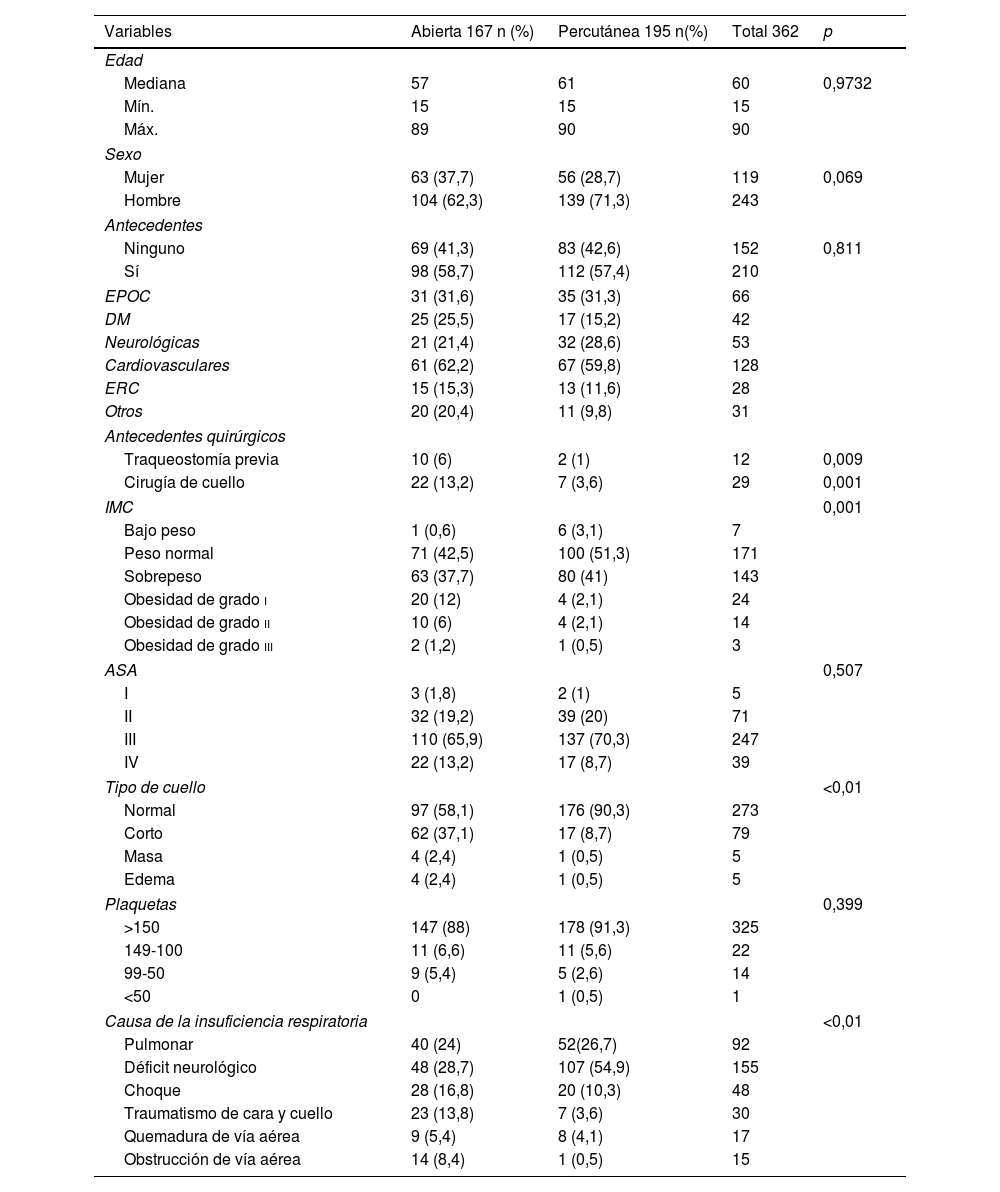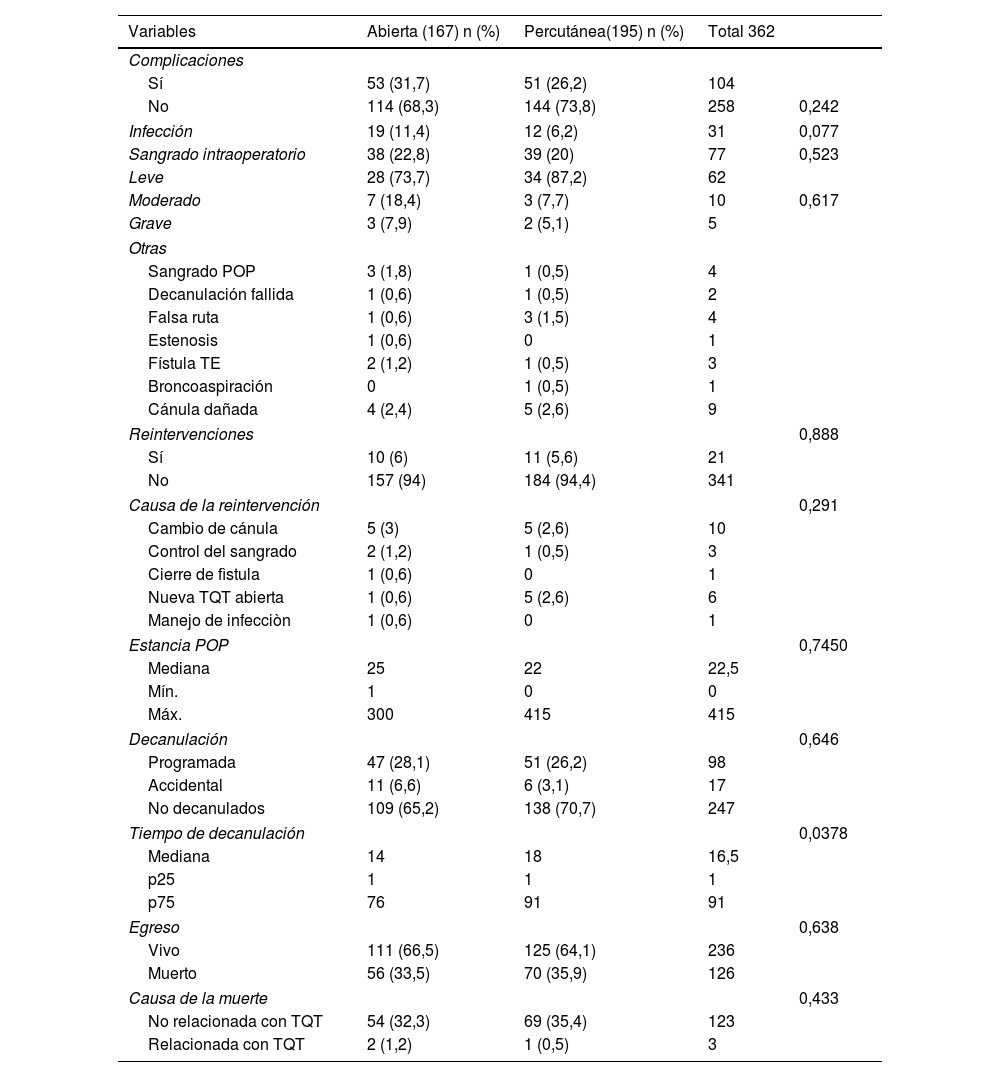Existen 2tipos de traqueostomía: abierta (TA) y percutánea (TP). No hay consenso sobre la técnica de elección para la mayoría de los pacientes, por lo que es necesario hacer estudios sobre los resultados clínicos con el uso de las 2técnicas.
ObjetivoComparar los resultados clínicos de pacientes intervenidos mediante TA y TP en la Unidad de Cuidado Intensivo del Hospital Universitario San José entre 2013 y 2018.
MétodosEstudio observacional de corte transversal. Se realizó un análisis descriptivo y posteriormente se compararon las 2técnicas usando la prueba χ2 de Pearson para las variables cualitativas y la prueba U de Mann-Whitney para las cuantitativas.
ResultadosSe incluyó a 362 pacientes; a la mayoría (53,87%) se le realizó TP. Ambos grupos fueron similares respecto a las características clínicas y sociodemográficas. El IMC fue menor para las TP (p = 0,001). El tiempo de estancia en UCI no tuvo diferencias, con 19 y 17 de mediana para pacientes con TA y TP, respectivamente (p = 0,287). Solo cirujanos realizaron TA y en las TP, el 35,38% las hicieron anestesiólogos, el 32,82% cirujanos y el 32,31% intensivistas. La complicación más frecuente fue sangrado, seguida por infección aunque sin diferencia estadísticamente significativa. La mortalidad global fue del 34,8%, con el 0,83% secundaria al procedimiento.
ConclusionesAmbas cirugías mostraron ser seguras, con prevalencia similar en cuanto a complicaciones. Las TP pueden ser realizadas por diferentes profesionales, sin que aumenten las complicaciones. Hubo diferencia en el tiempo de decanulación: se debería ampliar este ítem en futuras investigaciones.
There are 2types of tracheostomy: open (OT) and percutaneous (PT). There is no consensus on the technique of choice for the majority of patients, it is necessary to carry out studies on the clinical results with the use of the 2techniques.
ObjectiveCompare the clinical results in patients undergoing OT and PT in the intensive care unit of Hospital Universitario San José, Colombia between 2013 and 2018.
MethodsObservational cross-sectional study. A descriptive analysis was made and later both techniques were compared using Pearson's χ2 test for qualitative variables and the Mann-Whitney U test for quantitative ones.
ResultsThree hundred and sixty-two patients were included, most underwent PT corresponding to 53.87%. Both groups were similar with respect to clinical and sociodemographic characteristics. The BMI was lower for the TP (P = 0.001). The length of stay in the ICU did not differ, with a median of 19 and 17 for patients with OT and PT, respectively (P = 0.287). Only surgeons performed OT and in PT 35.38% were anesthesiologists, 32.82% surgeons and 32.31% intensivists. The most frequent complication was bleeding, followed by infection, although without a statistically significant difference. Overall mortality of 34.8%, with 0.83% secondary to the procedure.
ConclusionsBoth surgeries proved to be safe, with a similar prevalence in terms of complications. PT can be performed by different professionals, without increasing complications. There was a difference in decannulation time, this item should be expanded in future research.
Artículo
Socios de la Asociación de Medicina Crítica y Cuidado Intensivo
Para acceder a la revista
Es necesario que lo haga desde la zona privada de la web de la AMCI, clique aquí
Comprando el artículo el PDF del mismo podrá ser descargado
Precio 19,34 €
Comprar ahora









